Kenya
Adaptations for maize farms across diverse landscapes
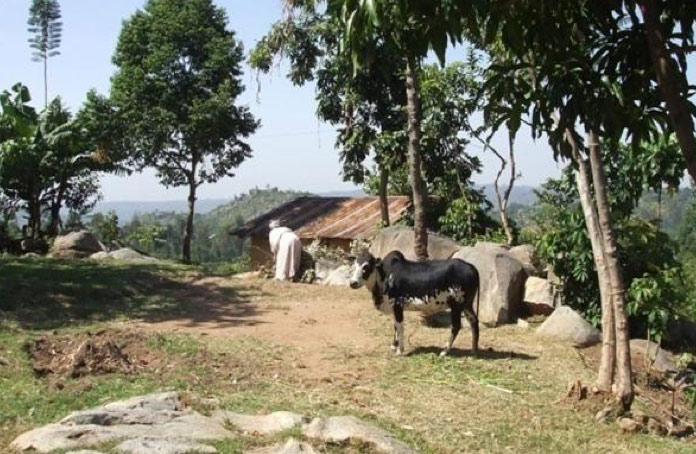
Current Farming System
70 Locations in Kenya
Smallholder farms
Rain fed
High, medium and low potential maize zones
Low inputs

CLIMATE 2050s
Increase in maximum temperatures between 2.5 and 3.4°C.
Variable rainfall projections

Impacts
Maize, as it is grown today, is vulnerable to climate change in all agro-ecological zones
In a high emission future maize yields could:
decrease up to 28% in the high potential zone
decrease up to 16% in the medium potential zone
decrease up to 13% in the low potential zone

VULNERABILITY 2050s
50% to 70% of all farms could be vulnerable to the impacts of climate change
Per-captia is projected to decrease and poverty increase
Farms in the high maize potential zone are the most vulnerable

Adaptations
Policy interventions for current farms could lead to maize yield increases of 66% to 126%
80% of future farms could benefit from adaptations of increased fertilizer and improved livestock breed
 Results Overview
Results Overview
The study area covers a large area of Kenya where maize is one of the major crops. In particular, the assessment is carried out on ~1000 farm households clustered around more than 70 maize-growing regions from the Kenyan coast through the central highlands to the western side of the country. The locations are grouped into three categories: high maize potential zone, medium maize potential zones, and low maize potential zones. These groupings are based on the village agro-ecological zones.

Map of the study area with agro-ecological zones. The low maize potential region is along the coastline and eastern and southern lowlands. Medium maize potential is located along the central and western highlands, the western transitional, the western lowlands, and within the rift valley. High potential zone is generally where higher precipitation falls.
This regional integrated assessment provides a number of insights into the potential impact of climate change and adaptation on maize-based systems in Kenya. First, all the climate models predict a warmer future compared to the current climate; and, the future scenarios are warmer in the higher emissions pathway. The projected increase in temperature is lowest at the coast and increases westward, with the largest increases at the sites near the Kenya-Uganda border. The climate models are in less agreement on the direction of change in precipitation compared to current levels. Based on previous work, there is reason to believe that climate models have relatively low skill in reproducing East Africa precipitation climatology which leads to uncertainty as to whether the region will be wetter or drier in the future (Yang et al. 2015), although recent trends toward drying underscore a need to manage the risk of a drier future.
This assessment finds that projected climate change in Kenya negatively impacts current maize-based systems. Crop model simulations indicate that, with current management, maize yields are lower in future climate scenarios compared to current climate. The decrease in maize yields leads to lower farm net returns for a majority of farms across the future climate scenarios and across the maize-producing regions of Kenya. However, there is heterogeneity in the impacts across Kenya: the farms in the high potential maize zone are potentially the most vulnerable to climate change. In the worst case hot and dry climate scenario, maize yields in this area are predicted to decrease by a larger degree than in the low and medium potential zones. Moreover, farms in the high potential zone are more reliant on maize than the other zones where household income is relatively diversified across off-farm work, maize, other crops, and livestock.
In terms of potential adaptation, a large portion of farms in current maize-based systems may benefit from a policy intervention aimed at decreasing fertilizer prices and increasing milk productivity. This intervention is represented by a subsidy that lowers the prices farmers pay for commercial fertilizers and improves access to fertilizers with investment in infrastructure and lowering transactions costs associated with participating in fertilizer markets. The technological intervention also includes technical assistance programs to improve feeding strategies for milking cows and the donation of one improved breed milking cow to every farm, similar to the basic elements of the East Africa Dairy Development project (EADD 2013, 2014). Both maize and milk productivity are predicted to increase under the intervention, which leads to increases in farm net returns for households across Kenya. By increasing farm net returns, the intervention is expected to increase per-capita income and lower the poverty rate.
Findings in regards to climate impact on future maize-based systems illustrate the importance of examining both biophysical and economic changes that result from climate change. From a biophysical standpoint, the crop model predicts that maize yields under future management are negatively impacted by climate across Kenya in a number of moderate emission scenarios and most high emission scenarios. However, these lower yields do not necessarily lead to negative economic impacts because, according to the global economic model (IMPACT), global trends and market competition leads to higher prices in climate change scenarios compared to a future without climate change. As such, the economic impacts of climate change are the result of both biophysical and economic changes that occur with climate change.
In this assessment, the higher prices with climate change tend to offset the negative climate impact on yields, leading to aggregate predictions of positive net impacts on mean farm net returns, increases in per-capita farmer income, and decreases in rural poverty across the future scenarios. Higher prices are likely to have negative consequences on non-farming households, however. In the high potential zone, the range of outcomes includes negative net economic impacts from climate change. First, these farms are projected to be the most negatively impacted from a biophysical standpoint in the worst-case scenarios, and second, they obtain the most income from maize, which has relatively smaller price increase with climate change than the price increases for other crops. When combined, these two factors yield projections of lower farm net returns and a majority of households being worse off with climate change in the high maize potential zone. Despite the aggregate outcomes, the strata level results predict that climate impacts differ based on location agro-ecology and household income diversification.
As in current production systems, a large majority of farms in future production systems are predicted to benefit from a policy intervention aimed at increasing fertilizer application and milk production. This intervention is modelled with increased fertilizer and manure application and the provision of 2-3 improved breed cows to each farm in future production systems. The changes in maize management increase yields and offset negative climate impacts. The provision of multiple improved breed cows increases both milk production and milk productivity. As a result, maize and milk net returns tend to increase for farms across Kenya, leading to increases in per-capita income and decreases in poverty in each of the future scenarios. The large increase in milk net returns is the main driver in the positive outcomes associated with the intervention. This result suggest that policy interventions aimed at increasing the farms' focus on milk production, including the use of improved breeds, have the potential to greatly improve livelihoods in future maize-based systems of Kenya.
 Farming System
Farming System

Farm in Kenya
The study area covers a large area of Kenya where maize is one of the major crops. In particular, the assessment is carried out for ~1000 farming households in over 70 locations from the Kenyan coast through the central highlands to the western side of the country. The locations are grouped into three categories: high maize potential zone, medium maize potential zones, and low maize potential zones. These groupings are based on the village agro-ecological zones.
The growing season in this assessment is March - July. The rainfall and temperatures across the study sites varies considerable during this season. Along the coast (low maize potential), the average growing season rainfall is generally above 600 mm. The sites in the eastern and southeastern lowlands (low maize potential) have the lowest average growing season rainfall, between 200 mm and 400 mm. Most of the sites within the central and western highlands, the western transitional, and the western lowlands (medium maize potential) have the highest growing season rainfall of between 800 mm and 1000 mm, and in some cases, rainfall exceeds 1000 mm. In the high maize potential zone, 500 mm to 600 mm is the average rainfall for most sites, however, there are some areas that receive above 800 mm. Within the rift valley there are some sites at the marginal rain shadow (medium maize potential) that have the lowest rainfall of between 300 mm and 400 mm over the western parts of the country. The average temperature pattern for Kenya during the maize growing season also exhibits differences across the country. The coastal region and the southeastern parts of the country have the highest average growing season temperatures (above 240 C), followed by the western parts and a swath within the southeastern region that borders the central areas. The coolest part of the country is within the rift valley where the average temperature during the growing season ranges between 15°C and 18°C. The central region and the western highlands have an average temperature of between 18°C and 21°C.
Farm sizes differ across the regions but are generally small. Households in the low and medium potential zones tend to receive a smaller amount of income from maize than households in the high potential zone. Other than maize, the most common crops in the sample are bananas, beans, cowpeas, potatoes, avocados, mangos, sweet potatoes, onions, and Sukuma wiki. These crops tend to make up a greater share of income than maize in the medium and low potential zones. Moreover, milk net returns provide a substantial amount of income and poverty rates are lower for households with milk sales. The income statistics indicate that households are generally diversified across maize, other crops, livestock, and off-farm income sources in the maize-based systems in Kenya.
There is some variation in the use of inputs (such as fertilizer) across the agro-ecological zones; however, the systems are generally characterized by low input use. The households are stratified for the economic analysis based on maize potential of their village agro-ecology. Moreover, the households within each maize potential zone are stratified according to whether they sell milk or not. These factors tend to create large differences between groups of households in terms of maize productivity and farm net returns.
The households in the high potential zone tend to have a greater amount of area allocated to maize production and have higher input use than those in the other zones. Specifically, almost all of these households use more modern hybrid seed and, on average, these households apply more nitrogen fertilizer and have higher land preparation costs than households in the other zones. Hybrid use is also high in the medium potential zones and these households use more nitrogen fertilizer and manure than those in the low zones. The area allocated to maize tends to be lower on the farms in the medium potential zones compared to the other zones. Looking to the low potential zones, less than half the households use hybrid maize seed and nitrogen fertilizer use is very uncommon.
Households also produce a number of livestock products. Milk is produced and sold by households in each zone. Moreover, households sell eggs, honey, hides, goat milk, wool, and manure as well. However, these activities tend to make up a small share of income compared to milk. In general, the average number of cows is between 1 and 2 across the maize potential zones. The overall herd size (total cattle) is highest in the high potential zone. Ownership of improved breed cattle is relatively rare compared to ownership of local and cross breeds. In terms of total milk production, the total production and milk yield are highest in the high potential zone and lowest in the low potential zones, on average.
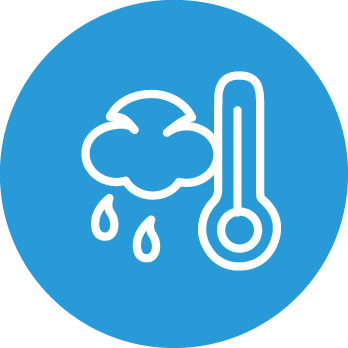 Climate Change Projections
Climate Change Projections
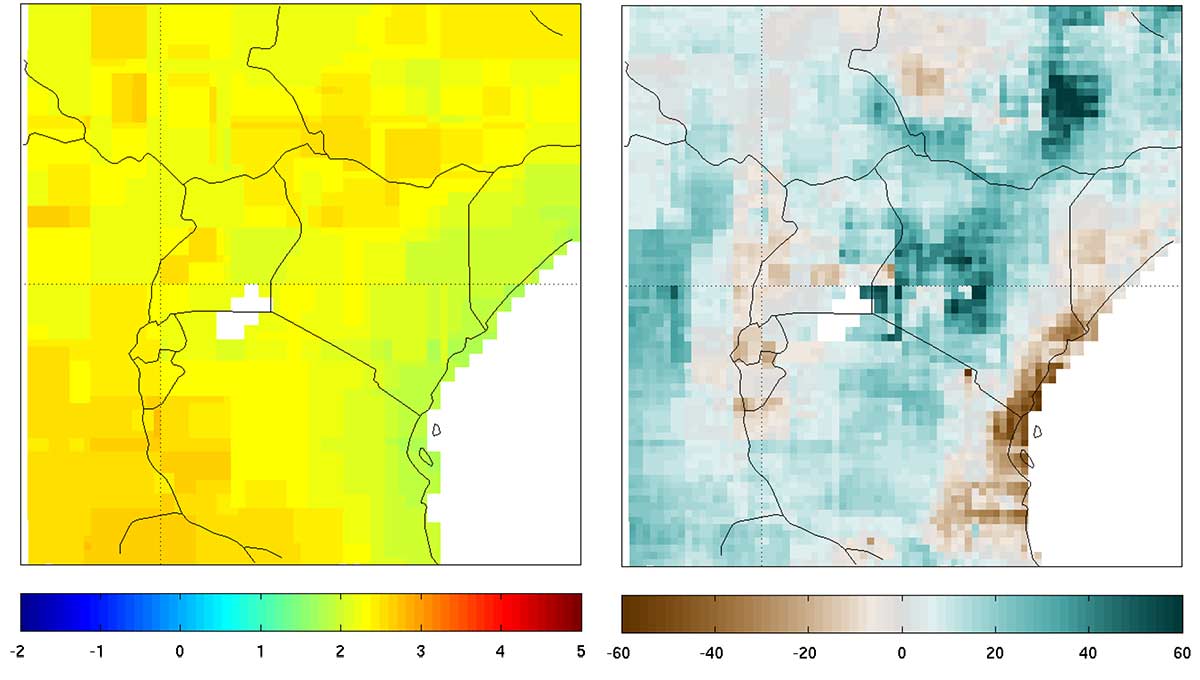
Median changes in May-June growing season (left) temperature (°C) and (right) total precipitation (mm) from 29 climate model simulations for Kenya and surrounding countries in East Africa in the 2050s under a high emissions climate change scenario, compared with the 1980-2010 historical period.
All the models project a warmer future that is warmer under the high emission future than the moderate emission future. Selected climate model scenarios project temperature increases of 0.6 to 3.4 °C during the mid-century period, with differences depending on proximity to coast, elevation, and emissions scenario. The projected increase in temperature is lowest at the coast and increases westward and is highest near the Kenya Uganda boarder.
Model projections of precipitation in the 2050s are variable. Under both emissions scenarios, the wettest scenarios indicate increases in precipitation the driest scenarios predict decreases in precipitation during the growing season. Under the moderate emission scenario the highest increase in precipitation projected is 35% and the highest decrease is -32% and under the high emission scenario the highest increase is 28% and the driest scenario is a decrease by -35%. Recent drying trends underscore the need to manage the risk of a hotter and drier future.
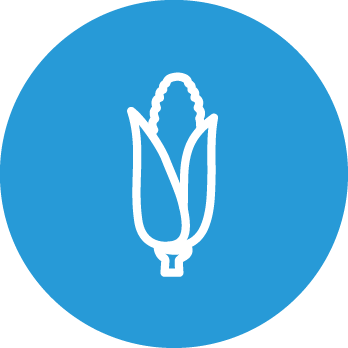 Climate Change Impacts
Climate Change Impacts

Impacts of climate change on maize yields in the current system for each agro-ecological zone (combined climate models and moderate and high emission scenarios)
Current System
Maize yields in current production systems are predicted to decline, on average, as a result of climate change. In the moderate emission scenario, the crop model simulations indicate all climate scenarios have negative average impacts on yields in the low and medium maize potential zones. The high maize potential zone has the largest range of average relative yields across the five climate scenarios; which includes a prediction of small, positive impacts in the cool/wet scenario.
The high emission scenarios are also predicted to negatively impact maize yields across Kenya. In general, the high emission climate scenarios appear to have larger negative impacts than those in moderate emissions. Moreover, there are no scenarios that are associated with positive impacts in any particular maize potential zone.

Impacts of climate change on maize yields in the future system for each agro-ecological zone (combined climate models and moderate and high emission scenarios)
Future System
Representative Agricultural Pathways (RAPs) narratives (see Green and Grey Roads below) indicate future agricultural systems will increase yields over current systems; this is also predicted by the global economic model, IMPACT. The elements of these future systems are similar in both RAPs but exhibit a few key differences. In both scenarios farmers increase fertilizer and manure application rates compared to the current time period but with differing amounts. Another component of both RAPs is the increased use of improved maize varieties. Lastly, the crop modelling for the Grey Road also incorporates degradation of the current soils. Soil degradation is consistent with the higher emission narrative which includes adverse environmental outcomes.
Under moderate emissions, in the low and medium potential zones, the results predict small climate impacts on future maize production; both positive and negative impacts are predicted across the climate scenarios. The high potential zone is predicted to experience small impacts, on average, in all climate models except the hot/dry scenario, where the average reduction in yields is 17%.
Across Kenya, the crop model predicts negative climate impacts on maize yields under high emissions. In each of the maize potential zones, the hot/dry climate scenario yields the lowest maize yields. The average reduction in yields in the hot/dry scenario is 13% in the low potential zones, 16% in the medium potential zones, and 28% in the high potential zone. Overall, development of the agricultural systems in the 2050s tends to reduce climate impacts, which are generally more positive than those that would affect the current system for all maize potential zones.
 Vulnerability
Vulnerability
Current Farms
The economic results across the various models predict that current maize-based systems in Kenya will be negatively impacted by climate change. The majority of households are vulnerable (i.e. have lower income with climate change) in each simulation. The economic simulations predict the percentage of vulnerable households to be between 50% and 70% across the models and relative yield assumptions. Moreover, per-capita income is predicted to decrease while poverty is predicted to increase.
Climate change impacts are generally more negative in the high emissions scenario than in the moderate emissions scenario: projecting more vulnerable households, lower per-capita incomes, and higher poverty rates. Moreover, farms in the high potential maize zone are potentially the most vulnerable to climate impact in Kenya. In the worst case, maize yields in this area are predicted to decrease by a larger degree than in the low and medium potential zones. Moreover, farms in the high potential maize zone are more reliant on maize than the other zones, where household income is relatively diversified across off-farm work, maize, other crops, and livestock.
There are two Representative Agricultural Pathways (RAPs) developed with stakeholders to model future agricultural systems for this analysis. Each RAP is associated with a different shared socio-economic pathway (SSP) and plausible level of emissions for the year 2050 (O'Neill et al. 2015, Valdivia et al. 2015).
The first RAP is referred to as the "Green Road" and is associated with a moderate emission scenario and a sustainability SSP. The sustainability SSP is characterized by inclusive global development that emphasizes human well-being and environmental awareness at the expense of faster long-run economic growth. In this Green Road pathway, there is large investment in environmental technologies, resource and energy efficiency, and improvement in environmental conditions. Due to these characteristics, there are low challenges to climate change mitigation and adaptation in the sustainability SSP.
The second RAP developed in this study, the "Grey Road", represents a future with high emissions and high growth that comes at the expense of the environmental unsustainability (a regional rivalry SSP). International fragmentation and competition between nations are key elements of this SSP. Poor international collaboration leads countries to focus on national concerns, leading to trade barriers and favorable policies for local resources and agricultural markets. Resource degradation increases over time because environmental issues are not a priority for international policy. Moreover, dependence on fossil fuels continues and there is lack of investment in energy and resource efficiency, culminating in poor progress towards sustainability and high challenges to both mitigation and adaptation.
RAP Sustainable development - Taking the Green Road
Under the Green Road, Kenya in the 2050s has implemented, with relative success, Vision 2030 focusing on meeting the Millennium Development goals and the Sustainable Development Goals. Increased investment in technologies that are environmentally friendly may help the country to be on a sustainable pathway. However, economic growth may slow as the main investments are focused on public services such as health, education, and clean energy. Policy changes and infrastructure improvements could facilitate the development of markets and the availability of agricultural inputs that lead to higher farm incomes. Farms may become more diversified and less dependent on maize; there may be increased crop-livestock integration and off-farm income. Moreover, household sizes may be smaller while farm sizes may be larger.
In the agro-ecological zones that have the highest potential for maize production (high and medium zones), maize yields may increase as a result of increased use of mineral fertilizers, manure (produced on-farm), and improved varieties. Productivity could also improve by increasing the availability of extension, education, and information to farmers. These changes could be accompanied by decreases in fertilizer prices, increases in seed prices, increases in labor wages, and increases in mechanization costs. There may also be a number of changes in livestock production due to government investment in infrastructure for the livestock and dairy sectors. Households could increase their herd sizes (including more improved breeds) and implement improved management practices, such as using more concentrates for feed. These changes could lead to higher milk yields and higher production costs. Moreover, due to market development, milk prices increase.
The areas of Kenya that have low agro-ecological potential for maize may experience different changes under the Green Road. The milk-selling farms could decrease their reliance on maize and focus more on milk production. The proportion of land area currently allocated to maize could decrease in order to increase the area of napier grass and pastures. On the remaining maize land, these households may institute similar improved management practices as those discussed above.
RAP Fossil fuel development - The Grey Road
Kenya may follow a more positive economic development trajectory in the Grey Road than in the Green Road. By the 2050s, the proposed agricultural interventions and policies outlined in Vision 2030 may not be fully implemented. The government may have an aggressive policy to promote the industry and services sector and it is plausible that there would be low investment in sustainable agricultural policies. Import barriers may be in place and could lead to increases in prices of imported goods, including mineral fertilizer. Low investment in health and education could contribute to an increase in inequality. High population growth may increase the pressure on agricultural land with the consequences of unsustainable agricultural intensification and negative environmental effects. Moreover, farms may become smaller in some areas while consolidation could occur in other areas.
In the high and medium potential zones, farms may increase their proportion of maize area compared to the current systems. Maize yields could increase due to similar management improvements as in the Green Road, except production occurs with more adverse environmental outcomes. For example, farms use less organic fertilizer and less soil conservation techniques compared to the Green Road, which could result in soil degradation. Similar to farm size, average herd sizes may not change compared to current systems, but there is could be increased variation as some farms increase their herds and others decrease. Milk yields may improve due to improved management and breeding, which leads to increased production costs as well. Moreover, milk price could increase for similar reasons as the Green Road, but to a lesser extent. There is a lower degree of crop-livestock integration than in the Green Road, as well. Households may not use the outputs from livestock activities (e.g. manure) as productive inputs in crop activities (and vice versa) to the same extent as in the Green Road.
In the areas with low maize potential, milk-selling farms could allocate land to napier grass and pastures, but to a lesser degree than in the Green Road. Maize production systems and milk production systems are similar to the Green Road but with increased soil degradation and less crop-livestock integration, resulting in lower manure use. In addition, milk prices do not increase to the same degree as the Green Road due to lower market development.
 Adaptation
Adaptation
What are the benefits of interventions on current agricultural systems?
Economic simulations suggest an increase in farm net returns for up to 86% of farms across the maize potential zones of Kenya following a new management regime of higher fertilizer and manure application in maize production, improved feeding for cows currently owned, and a new policy providing one improved breed cow to each farm . The adoption of this intervention is also associated with positive changes in per-capita income and negative changes in the poverty rate. Within each maize potential zone, the adoption rate is higher for the sub-population of farms without milk in current systems than for the subpopulation with milk in current systems. These relatively higher benefits are likely the result of the intervention providing an additional income stream for these farms. The economic benefits of this intervention result from yield improvements in maize and milk which, in turn, lead to increases in net returns. Yield improvements tend to increase revenue but also come with increased input costs for both maize and milk. In this case, the revenue that results from yield improvements tends to outweigh the excess costs and leads to increases in both maize and milk net returns.
What are the benefits of climate change adaptations on future agricultural systems?
Economic simulations predict that increased fertilizer and manure application and the provision of 2-3 improved breed cows to each farm improves the economic well-being of a large majority of Kenyan farms in the future scenarios. Specifically, around 80% of all farms are predicted to adopt the intervention, regardless of the RAP or climate scenario. The intervention increases farm net returns, which increases per-capita income and decreases poverty across Kenya in each of the future scenarios. There are two avenues by which the intervention affects farms. First, the intervention offsets negative climate impacts on maize productivity by increasing fertilizer and manure application. Moreover, in the Grey Road RAP, maize productivity is improved due to soil restoration practices. These productivity improvements lead to increases in maize net returns in each maize potential zone.
Second, the intervention includes the provision of 2-3 improved breed cows to each farm which roughly doubles the number of cows available for milk production. In addition, these cows are an improved breed that is generally more productive and profitable than the local and cross breeds commonly used by farms in Kenya. As such, the intervention leads to large increases in milk net returns. In fact, the changes in milk net returns outweigh those in maize net returns and are the main drivers in the positive outcomes associated with the intervention. These results suggest that policy interventions aimed at increasing the farms' focus on milk production, including the use of improved breeds, have the potential to greatly improve livelihoods in future maize-based systems of Kenya.
The two adaptation packages tested are described below.
Adaptation Package for Current Farms
This technological intervention is designed to increase maize yields across the agro-ecological zones in Kenya. In each zone, nitrogen fertilizer and manure use are increased. A policy intervention is required to incentivize increased usage of fertilizer. This intervention is represented by a subsidy that lowers the prices farmers pay for commercial fertilizers di-ammonium phosphate (DAP) and calcium ammonium nitrate (CAN) by 25%. Access to fertilizers is also improved due to investment in infrastructure and lowering transactions costs associated with participating in fertilizer markets. The technological intervention also includes the basic elements of the East Africa Dairy Development project that includes donating one improved breed milking cow to every farm (EADD 2013, 2014). Technical assistance programs are put in place to improve feeding strategies for milking cows as well. These improved strategies are instituted for all the cows on each farm (pre-existing and new).
Adaptation Package for Future Farms
The technology intervention for future maize-based systems in Kenya is consistent with that for current farms, however it is tailored to the future world with climate change. The goals of the intervention are to offset negative climate impacts on maize yields and capitalize on the profitability of milk production. This analysis is undertaken for future RAPs and their associated climate scenarios.
In both RAPs, there are future scenarios where average maize net returns are predicted to decrease as a result of climate change across Kenya. These negative economic impacts are the result of decreases in maize yields caused by climate change. As such, the technological intervention aims to increase maize yields in future climate scenarios by increasing fertilizer application each farm. In terms of milk production, the current farm analysis indicates that adding improved breed cows may substantially increase milk net returns in current production systems. To implement a similar intervention in future production systems, each farm is provided multiple improved breed cows. With the increase in herd size, farms also apply more manure with the intervention. The only difference between the intervention in the RAPs is related to soil improvement. In the Grey Road, soil quality is lower than in the current period and, as a result, the intervention includes soil improvement practices that restore soil to its current (2007) quality.
 Stakeholder Engagement
Stakeholder Engagement
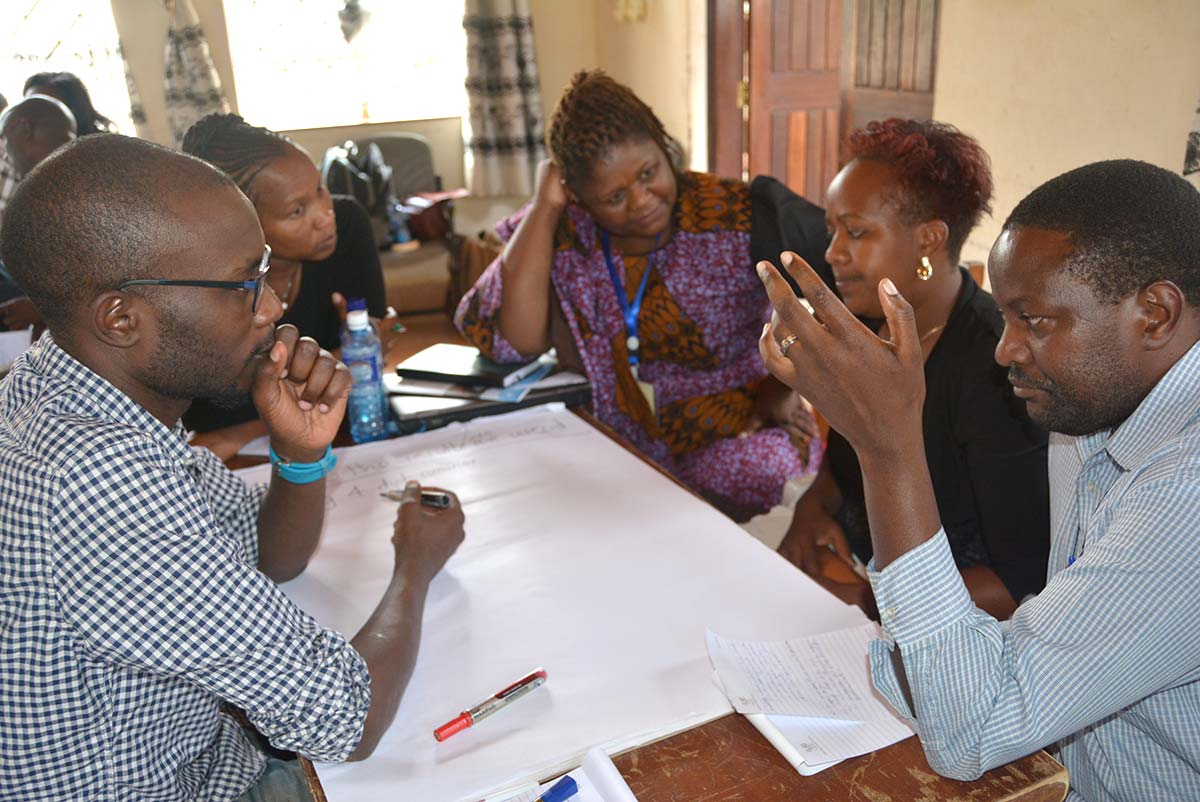
Discussions on adaptation packages for Makueni County, Kenya. (Photo:CCAFS)
The national (Kenya, Tanzania, Uganda) AgMIP teams packaged climate change adaptation research information from different sources for engagement with stakeholders at national level. The stakeholders discussed ideas based on guiding questions shared by the AgMIP facilitation team. Feedback was gathered from the stakeholders that was to be incorporated in the modeling process by the national teams.
The East Africa team recognized that the best engagement is demand-driven (from the stakeholders). Therefore the first step taken was to document the climate related risks that the people face, and what kind of solutions (help) they needed.
Stakeholders included the agricultural extension officers, County Chief Officer (policy maker), national climate change secretariat officers who focus on developing climate change adaptation strategies and programs, national agricultural research stations (both research institutes and national universities), and climate-smart agriculture project implementers. This provided a diversity of stakeholders who could share their experiences and expectations in relation to application of AgMIP deliverables.
At the sub-national level, the Makueni County of Kenya (which has a population of about one million people) was seeking more scientific information (case studies and recommendations) on options for climate change adaptation to help its citizens develop resilience to the changing climate. They were eager to use research findings from previous studies that were relevant to the County, in its operationalization of the 2013-2017 County Integrated Development Plan. The county passed a law that sets aside one per cent of its KES 5 billion annual development budget towards climate change adaptation. The County Climate Change Fund (CCCF) regulation passed by the Makueni County Assembly was the first of its kind in Kenya and Africa. The DFID Kenya Director Ian Mills lauded Makueni for setting the pace for other counties to follow.
 Learn More
Learn More
This research was made possible by generous support from the UK Department for International Development's UKaid.
This research is a part of the AgMIP Eastern Africa region project; more information is available here.
East Africa Team Members
| Lieven Claessens | Lead PI |
| Siza Tumbo | Co-PI |
| Gummadi Sridhar | Co-PI |
| Anthony Esilaba | Kenya coordinator |
| Moses Tenywa | Uganda coordinator |
| Caleb Dickson | Economic modeling; ARP |
| Fikadu Getachew | Crop modeling |
| Jemal Seid | Climate modeling |
| Adam Bekele | Economic modeling |
| Mary Kilavi | Climate modeling |
| Joseph Miriti | Crop modeling |
| Anthony Oyoo | Economic modeling; stakeholder interaction |
| Khamaldin Mutabazi | Economic modeling; TOA-MD |
| Ibrahim Kadigi | Economic modeling; TOA-MD |
| Barnabas M. Msongaleli | Crop modeling |
| Peter Mlonganile | Climate |
| David D. Maleko | Livestock |
| Majaliwa Mwanjalolo | Crop modeling |
| Patrick Musinguzi | Crop modeling |
| Josephine Nampiija | Crop Modeling |
| Carol Nandozi | Climate |
| Jackline Bonabana-Wabbi | Economics modeling; TOA |
| Kelvin Shikuku | RIA, TOA, economics |
| Caroline Mwongera | RIA, TOA, bio-physical |
| John Recha | Stakeholder liaison |
| Maren Radeny | Stakeholder liaison |
Affiliated Institutions
The International Crops Research Institute for Semi-Arid Tropics (ICRISAT) – Kenya
The Ethiopian Institute of Agricultural Research
The Kenya Meteorological Society
Kenya Agriculture and Livestock Research Organization
Sokoine University of Agriculture, Tanzania
Makerere University, Uganda
International Center for Tropical Agriculture (CIAT)
Climate Change, Agriculture, and Food Security (CCAFS) Research Program – Kenya
References
Antle, J.M., R.O. Valdivia, K. Boote, S. Janssen, J.W. Jones, C.H. Porter, C. Rosenzweig, A.C. Ruane, and P.J. Thorburn, 2015: AgMIP's transdisciplinary agricultural systems approach to regional integrated assessment of climate impacts, vulnerability, and adaptation. In: Rosenzweig C., and D. Hillel (eds) Handbook of Climate Change and Agroecosystems: The Agricultural Model Intercomparison and Improvement Project (AgMIP). ICP Series on Climate Change Impacts, Adaptation, and Mitigation Vol. 3. Part 1, Imperial College Press, 27-44, doi:10.1142/9781783265640_0002.
Rosenzweig C., J.W. Jones, J.L. Hatfield, A.C. Ruane, K.J. Boote, P. Thorburn, J.M. Antle, G.C. Nelson, C. Porter, S. Janssen, S. Asseng, B. Basso, F. Ewert, D. Wallach, G. Baigorria, and J.M. Winter, 2013: The Agricultural Model Intercomparison and Improvement Project (AgMIP): Protocols and Pilot Studies. Ag. For. Meteor., 170, 166-182. http://dx.doi.org/10.1016/j.agrformet.2012.09.011
Ruane, A.C., and S. McDermid, 2017: Selection of a representative subset of global climate models that captures the profile of regional changes for integrated climate impacts assessment. Earth Perspectives, In review.
